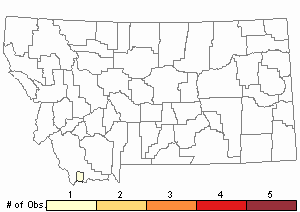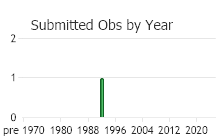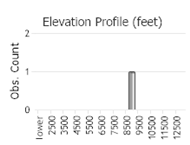View in other NatureServe Network Field Guides
NatureServe
Montana
Utah
Wyoming
Idaho
Wisconsin
British Columbia
South Carolina
Yukon
California
New York
Parry's Mountain Rabbitbrush - Ericameria parryi var. montana
Other Names:
Chrysothamnus parryi ssp. montanus
State Rank Reason (see State Rank above)
A globally rare endemic, restricted to a small area of southwest Montana and adjacent Idaho. Though only known from one population in Montana with an estimated couple hundred plants, its habitat is remote and there are no apparent threats to its viability in the near future. Additional data on population levels and trend should be collected.
- Details on Status Ranking and Review
Population Size
Score3 - Vey Small: Generally <2,000 individuals.
Range Extent
Score3 - Local Endemic or Very Small Montana Range: Generally restricted to an area <10,000 sq. miles (equivalent to the combined area of Phillips and Valley Counties) or <6 Sub-basins (4th code watersheds) Range-wide OR limited to one Sub-basin in Montana
Area of Occupancy
Score3 - Very Low: Generally occurring in 3 or fewer Subwatersheds (6th Code HUC’s).
Environmental Specificity
Score2 - High: Species is restricted to a highly specialized and limited habitat and is typically dependent upon unaltered, high-quality habitat (C Values of 8-10).
Trends
ScoreNA - Rank factor not assessed.
CommentTrends are unknown, though declines, if any, probably are not severe.
Threats
Score0 - Low: Impacts, if any, to the species are expected to be minor or insignificant (affecting <10% of populations) in severity, scope and immediacy.
CommentNo identified threats.
Intrinsic Vulnerability
Score0-1 - Low to Moderate Vulnerability.
Raw Conservation Status Score
Score
11 to 12 total points scored out of a possible 16 (Rarity factors and threats only)
General Description
Chrysothamnus parryi ssp. montanus is a low growing, branching shrub with stems mostly covered by compacted, feltlike hairs (not always easy to see). It has linear leaves 0.5-1.5 inches long that are somewhat sticky to the touch. The inflorescence has one or a few heads and is overtopped by the uppermost stem leaves. Each head is about 0.5 inch long and usually contains 8-10 yellow disk flowers, but no ray flowers. The bracts forming the base of each head are lance-shaped with hairs spaced along the margins and long, pointed green tips. They overlay each other like shingles on a roof. The seeds have numerous long, thin, stiff hairs at the top.
Phenology
Flowering occurs in August - September.
Diagnostic Characteristics
Chrysothamnus parryi ssp. montanus is a low shrub with white stems, linear, glabrous leaves, the inflorescence overtopped by the uppermost leaves, and involucral bracts aligned in vertical ranks. This set of morphological characters combined with its high-elevation habitat distinguishes it from other similar species.
Species Range
Montana Range
Range Descriptions

 Native
Native
Range Comments
Ericameria parryi ssp. montanus is a narrow endemic known only from the Red Conglomerate Peaks area, near the Continental Divide, in the southern Beaverhead Range of Idaho and adjacent Montana. Its global distribution extends over an area approximately four miles wide by two miles wide. The four known occurrences are more or less evenly distributed across this limited range (Mancuso and Moseley 1990).
Observations in Montana Natural Heritage Program Database
Number of Observations: 1
(Click on the following maps and charts to see full sized version)
Map Help and Descriptions
Relative Density

Recency



 (Observations spanning multiple months or years are excluded from time charts)
(Observations spanning multiple months or years are excluded from time charts)
Habitat
Sparsely-vegetated, subalpine grasslands and slopes usually on calcareous, gravelly to rocky soils.
Ecological Systems Associated with this Species
- Commonly Associated with these Ecological Systems
Alpine Systems
Grassland Systems
Ecology
POLLINATORS The following animal species have been reported as pollinators of this plant species or its genus where their geographic ranges overlap:
Bombus bifarius,
Bombus centralis,
Bombus huntii, and
Bombus melanopygus (Williams et al. 2014).
Threats or Limiting Factors
STATE THREAT SCORE REASON
Threat impact not assigned because threats are not known (MTNHP Threat Assessment 2021).
References
- Literature Cited AboveLegend:
 View Online Publication
View Online Publication Williams, P., R. Thorp, L. Richardson, and S. Colla. 2014. Bumble Bees of North America. Princeton, NJ: Princeton University Press. 208 p.
Williams, P., R. Thorp, L. Richardson, and S. Colla. 2014. Bumble Bees of North America. Princeton, NJ: Princeton University Press. 208 p.
- Additional ReferencesLegend:
 View Online Publication
View Online Publication
Do you know of a citation we're missing? Anderson, L. C. 1978. New taxa in Chrysothamnus, section Nauseosi (Asteraceae). Phytologia 38(4): 309-320.
Anderson, L. C. 1978. New taxa in Chrysothamnus, section Nauseosi (Asteraceae). Phytologia 38(4): 309-320. Anderson, L. C. 1986. An overview of the genus Chrysothamnus (Asteraceae). Pages 29-45 in E. D. McArthur and B. L. Welch, compilers, Proceedings- Symposium on the Biology of Artemisia and Chrysothamnus. USDA Forest Service General Technical Report INT-200. Intermountain Research Station, Ogden, UT.
Anderson, L. C. 1986. An overview of the genus Chrysothamnus (Asteraceae). Pages 29-45 in E. D. McArthur and B. L. Welch, compilers, Proceedings- Symposium on the Biology of Artemisia and Chrysothamnus. USDA Forest Service General Technical Report INT-200. Intermountain Research Station, Ogden, UT. Lesica, P. 1992. Conservation status of Chrysothamnus parryi ssp. montanus on Beaverhead National Forest, Montana. Montana Natural Heritage Program, Helena. 21 pp.
Lesica, P. 1992. Conservation status of Chrysothamnus parryi ssp. montanus on Beaverhead National Forest, Montana. Montana Natural Heritage Program, Helena. 21 pp. Lesica, P., M.T. Lavin, and P.F. Stickney. 2012. Manual of Montana Vascular Plants. Fort Worth, TX: BRIT Press. viii + 771 p.
Lesica, P., M.T. Lavin, and P.F. Stickney. 2012. Manual of Montana Vascular Plants. Fort Worth, TX: BRIT Press. viii + 771 p. Lesica, P., M.T. Lavin, and P.F. Stickney. 2022. Manual of Montana Vascular Plants, Second Edition. Fort Worth, TX: BRIT Press. viii + 779 p.
Lesica, P., M.T. Lavin, and P.F. Stickney. 2022. Manual of Montana Vascular Plants, Second Edition. Fort Worth, TX: BRIT Press. viii + 779 p. Mancuso, M. and R.K. Moseley. 1990. Field investigation of Chrysothamnus parryi ssp. montanus: a Region 4 sensitive species on the Targhee National Forest. Boise, ID: Idaho Department of Fish and Game. 11 p. + appendices.
Mancuso, M. and R.K. Moseley. 1990. Field investigation of Chrysothamnus parryi ssp. montanus: a Region 4 sensitive species on the Targhee National Forest. Boise, ID: Idaho Department of Fish and Game. 11 p. + appendices. U.S. Department of Agriculture, Forest Service. Idaho and Wyoming endangered and sensitive plant field guide. [n.d.]. Ogden, UT: U.S. Department of Agriculture, Forest Service, Intermountain Region. 192 p.
U.S. Department of Agriculture, Forest Service. Idaho and Wyoming endangered and sensitive plant field guide. [n.d.]. Ogden, UT: U.S. Department of Agriculture, Forest Service, Intermountain Region. 192 p. U.S. Department of Agriculture, Forest Service. Idaho and Wyoming endangered and sensitive plant field guide. [n.d]. Ogden, UT: U.S. Department of Agriculture, Forest Service, Intermountain Region. Pp:86-87.
U.S. Department of Agriculture, Forest Service. Idaho and Wyoming endangered and sensitive plant field guide. [n.d]. Ogden, UT: U.S. Department of Agriculture, Forest Service, Intermountain Region. Pp:86-87.
- Web Search Engines for Articles on "Parry's Mountain Rabbitbrush"





